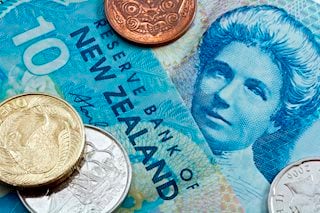NZD/USD softens below 0.6000 as RBNZ says economic downturn could get worse
|
- NZD/USD edges lower to 0.5970 in Tuesday’s Asian session.
- Markets are widely expecting the Fed to cut rates by 25 bps when it announces its policy decision on Thursday.
- The RBNZ stated the economic conditions remain challenging and business is doing it tough.
The NZD/USD pair weakens to near 0.5970 on Tuesday during the Asian trading hours. The modest recovery of the US Dollar (USD) and the remarks from the Reserve Bank of New Zealand (RBNZ) weigh on the pair. Investors brace for the outcome of the US presidential election, which might trigger the volatility in the financial markets.
The decline in the Greenback is likely due to a poll released over the weekend that reduced the probability of Republican Donald Trump winning the elections. Analysts said a Harris win might benefit the riskier currencies like the New Zealand Dollar (NZD), while a Trump victory could support the USD due to expected protectionist policies and higher inflation.
On Thursday, the Federal Reserve will announce its latest policy decision, with markets widely anticipating that the US central bank will cut interest rates by a quarter percentage point. Financial markets are now pricing in nearly a 98% possibility of a quarter point reduction and a near 80% odds of a similar-sized move in December, according to CME's FedWatch tool.
On the Kiwi front, the RBNZ noted on Tuesday that the economic conditions remain challenging and business is doing it tough, adding that geopolitical tensions are the key risk for the economy. The RBNZ began cutting the Official Cash Rate (OCR) in August and stepped up the pace last month when it lowered the OCR by 50 bps to 4.75%. Most economists expect another 50 bps reduction on November 27.
New Zealand Dollar FAQs
The New Zealand Dollar (NZD), also known as the Kiwi, is a well-known traded currency among investors. Its value is broadly determined by the health of the New Zealand economy and the country’s central bank policy. Still, there are some unique particularities that also can make NZD move. The performance of the Chinese economy tends to move the Kiwi because China is New Zealand’s biggest trading partner. Bad news for the Chinese economy likely means less New Zealand exports to the country, hitting the economy and thus its currency. Another factor moving NZD is dairy prices as the dairy industry is New Zealand’s main export. High dairy prices boost export income, contributing positively to the economy and thus to the NZD.
The Reserve Bank of New Zealand (RBNZ) aims to achieve and maintain an inflation rate between 1% and 3% over the medium term, with a focus to keep it near the 2% mid-point. To this end, the bank sets an appropriate level of interest rates. When inflation is too high, the RBNZ will increase interest rates to cool the economy, but the move will also make bond yields higher, increasing investors’ appeal to invest in the country and thus boosting NZD. On the contrary, lower interest rates tend to weaken NZD. The so-called rate differential, or how rates in New Zealand are or are expected to be compared to the ones set by the US Federal Reserve, can also play a key role in moving the NZD/USD pair.
Macroeconomic data releases in New Zealand are key to assess the state of the economy and can impact the New Zealand Dollar’s (NZD) valuation. A strong economy, based on high economic growth, low unemployment and high confidence is good for NZD. High economic growth attracts foreign investment and may encourage the Reserve Bank of New Zealand to increase interest rates, if this economic strength comes together with elevated inflation. Conversely, if economic data is weak, NZD is likely to depreciate.
The New Zealand Dollar (NZD) tends to strengthen during risk-on periods, or when investors perceive that broader market risks are low and are optimistic about growth. This tends to lead to a more favorable outlook for commodities and so-called ‘commodity currencies’ such as the Kiwi. Conversely, NZD tends to weaken at times of market turbulence or economic uncertainty as investors tend to sell higher-risk assets and flee to the more-stable safe havens.
Information on these pages contains forward-looking statements that involve risks and uncertainties. Markets and instruments profiled on this page are for informational purposes only and should not in any way come across as a recommendation to buy or sell in these assets. You should do your own thorough research before making any investment decisions. FXStreet does not in any way guarantee that this information is free from mistakes, errors, or material misstatements. It also does not guarantee that this information is of a timely nature. Investing in Open Markets involves a great deal of risk, including the loss of all or a portion of your investment, as well as emotional distress. All risks, losses and costs associated with investing, including total loss of principal, are your responsibility. The views and opinions expressed in this article are those of the authors and do not necessarily reflect the official policy or position of FXStreet nor its advertisers.